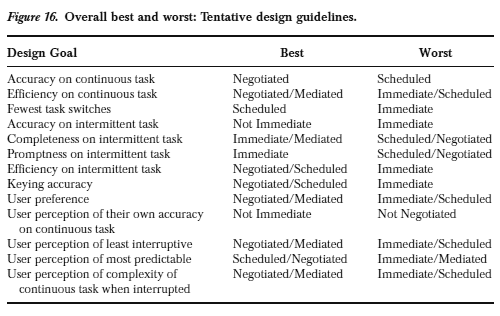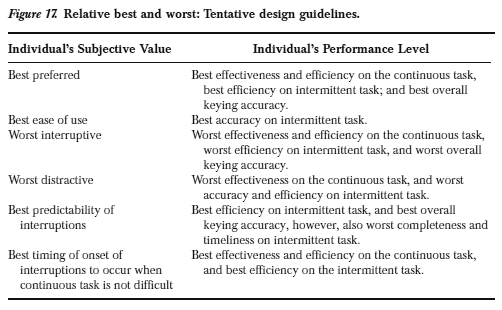Source
McFarlane D. C. (2002) Comparison of four
primary methods for coordinating the interruption of people in
human-computer interaction, Human-Computer Interaction,
17 (1), 63-139. [PDF 405KB]
Summary
This article presents an empirical study of several methods of interruption management in a time-sensitive visual task. These results have also been published separately in another article (McFarlane 1999) and McFarlane's dissertation (1998). Key findings supported by empirical results are summarized in the following tables. The first maps individual performance criteria to the interruption strategies that produced the best and worst result for each. The second shows significant correlations between user preference variables and user performance variables.


Relevance
This study has a very clear relevance to a driving task, since it involves a highly visual, time-sensitive, and continuous main task and a visual secondary task which obscures information used in the main task. This version provides a more complete discussion of validity and a much more detailed analysis than the 1999 version. The discussion of results is also expanded over the dissertation version (McFarlane 1998), particularly in the consideration of individual differences. The results highlight the complexity of the design question and the need to clearly prioritize which aspects of driving behavior we wish to support. Unfortunately it also reveals a clear deficiency in quantity of empirical research for this domain.
The strong performance under a negotiated interruption strategy is promising and should be investigated. If the driver must be interrupted in a Notify style for some reason, this may be the best way to do it. There may also be some benefit for the Check and Continue switch types. This strategy appears to be prefered by users as well. Even in this task, where cognitive workload was easy to estimate, the mediated interruption strategy produced mediocre performance. Workload estimation is likely to be unreliable and highly impractical under realistic driving conditions, making this option even less appealing. The scheduled and immediate interruption strategies produced unacceptably poor performance on the main task and should probably be avoided in a driving context.
The informal observations in section 7.1 highlight a potentially critical individual difference. McFarlane observed that some users seem capable of mentally simulating the continuous, dynamic task even while engaged in the discrete interruption task. These users were able to devise and use effective strategies for interleaving the two tasks. Other users could not or did not take advantage of this ability. They often neglected a backgrounded task until the foreground task was completed to some threshold of satisfaction. It is easy to see how any extended interaction with an in-vehicle device would be dangerous for the second class of user. Explicit lock-out protocols may be necessary to ensure that these users are not placed into a dangerous situation. Further research will be necessary to distinguish the two types of user and identify the factors that influence the two types of behavior.
Section 7.3 discusses the sticky issue of user preferences. Although 17 of 36 participants ranked the negotiated method as their top choice, five ranked it last and four ranked it third. These preferences were also significantly correlated to individual performance results. If these findings can be generalized to a driving context, it may be necessary to support flexible interaction styles in order to accommodate all users. Furthermore, section 7.11 suggests that a combination of methods may be better than any of them alone. A negotiation-mediation hybrid seems the most promising of these combined strategies, allowing the user to override or enhance the performance of the mediation algorithm.